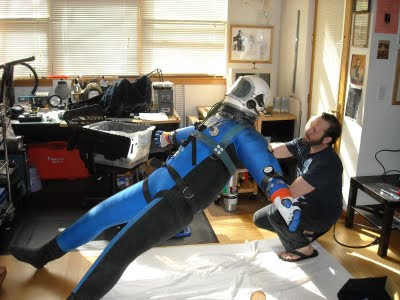

Solved one leak with a slight adjustment to the neck interface, and brought the suit up to a good pressure of 3psi, which would allow me to survive at 50,000 feet if I am breathing pure oxygen, which is what I plan to do. Quite a thrill! Still, a slow leak that I have yet to find didn't allow maintaining that pressure for too long, so I still have my work cut out. I have to start vacuuming up all foreign objects before and after all work sessions now, as a single metal filing out of place could cause a leak. It becomes starkly clear why pressure suit production takes place in a 'clean room' environment, with nary a speck or dustball permitted! Can I seal off part of the condo to allow this? Is that needed? Something like it might be--though I have to remember that suits built in the 1930's did not use this technique, and did function--so that is a new project to work up, if only done by sealing off the work area with a temporary partition and a good vacuum cleaning system, and just keeping better care of my work environment.
In the photos above I am showing just how lightweight the suit is, and checking out the dorsal portion of the neck seal.


No comments:
Post a Comment